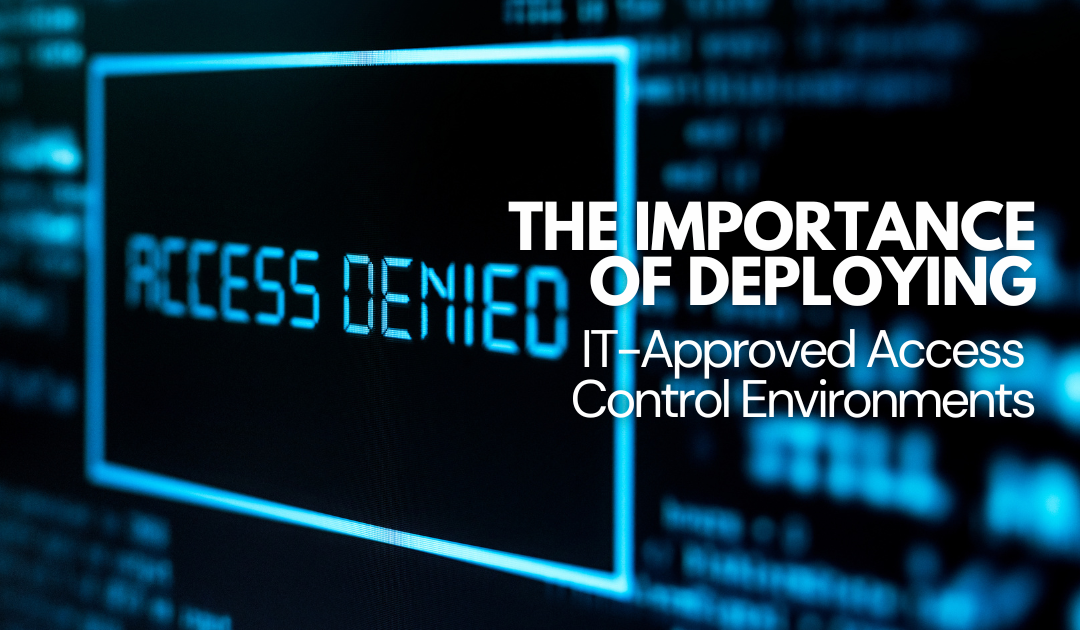Co-written with Robert Keegan, Senior Strategic Account Manager
Securing sensitive information and ensuring seamless access to critical resources have become paramount for organizations across all sectors. Access control systems, a fundamental component of IT infrastructure, play a crucial role in safeguarding data and maintaining operational efficiency. Deploying IT-approved access control environments is not merely a technological requirement but a strategic necessity. This blog explores the significance of setting up a robust IT access control architecture, emphasizing its impact on security, compliance, efficiency, and overall organizational resilience.
Setting up a proper architecture for IT access control systems is crucial for several reasons:
- Security: A well-designed architecture ensures that access to critical systems and data is restricted to authorized personnel only. This helps in preventing unauthorized access, data breaches, and other security incidents that could compromise sensitive information or disrupt operations.
- Compliance: Many industries and jurisdictions have regulatory requirements regarding data protection and access control. A proper architecture helps organizations comply with these regulations by implementing necessary controls, audits, and reporting mechanisms.
- Efficiency: A well-structured access control architecture streamlines the management of user privileges and access rights. This improves operational efficiency by reducing the time and effort required to grant, modify, or revoke access permissions as needed.
- Risk Management: Effective access control architecture supports risk management efforts by identifying and mitigating potential security risks associated with unauthorized access or misuse of IT resources. It helps in implementing policies and procedures to minimize these risks.
- Scalability: As organizations grow or evolve, their IT infrastructure and access control needs may change. A scalable architecture allows for the expansion of access control capabilities without significant redesign or disruption to existing systems.
- Integration: Modern IT environments are complex, often consisting of diverse systems and platforms. A well-planned architecture facilitates the seamless integration of access control mechanisms across different systems, applications, and environments.
- Auditability: Auditing access control activities is essential for monitoring compliance, detecting anomalies, and investigating security incidents. A structured architecture enables comprehensive logging, monitoring, and reporting of access control events for audit purposes.
- User Experience: Properly designed access control systems can enhance user experience by providing easy and secure access to resources based on roles and responsibilities. This improves productivity while maintaining security standards.
The protection of sensitive information and the secure management of resources are paramount concerns for organizations across all sectors. This heightened awareness has underscored the importance of deploying advanced access control systems that not only safeguard data but also ensure seamless and uninterrupted access for authorized users. At the heart of these systems lie proper IT architecture, high availability (HA), and failover servers—essential components that collectively enhance reliability, resilience, and operational continuity.
The Foundation: Proper IT Architecture
Proper IT architecture forms the bedrock upon which effective access control systems are built. It encompasses the design, integration, and management of various components that regulate and manage user access to critical resources. A well-structured IT architecture ensures:
- Security and Compliance: By defining clear boundaries and access policies, IT architecture minimizes the risk of unauthorized access and helps organizations adhere to regulatory requirements.
- Efficiency and Scalability: Scalable architecture accommodates growth and evolving technology needs, ensuring that access control systems remain efficient and adaptable over time.
- Integration and Interoperability: Seamless integration with existing IT infrastructure and applications enhances functionality and user experience while maintaining security standards.
Enhancing Reliability with High Availability (HA)
High availability (HA) is essential to ensure that access control systems operate continuously and reliably. Key features of HA include:
- Redundancy: HA systems incorporate duplicate components such as servers, network connections, and storage, ensuring that if one fails, another takes over seamlessly.
- Load Balancing: Distributing traffic evenly across multiple servers optimizes performance and prevents overload, enhancing overall system efficiency.
- Automatic Failover: Automated mechanisms redirect traffic to backup servers in the event of a primary server failure, minimizing downtime and ensuring uninterrupted service.
Best Practices for Deployment
To maximize the effectiveness of IT architecture, HA, and failover servers in access control systems, organizations should consider adopting best practices:
- Comprehensive Planning: Conduct thorough risk assessments and design IT architectures that prioritize security, scalability, and compliance.
- Redundant Infrastructure: Invest in redundant hardware and network configurations to mitigate single points of failure and enhance system reliability.
- Continuous Monitoring and Maintenance: Implement robust monitoring tools to track system performance, detect anomalies, and ensure timely maintenance and updates.
The deployment of high-level access control systems requires meticulous planning and execution. By embracing proper IT architecture, integrating high availability mechanisms, and leveraging failover servers, organizations can fortify their defences against threats, uphold data integrity, and maintain uninterrupted access for authorized users. These components not only enhance system reliability and resilience but also underscore a commitment to safeguarding sensitive information in today’s increasingly interconnected digital landscape. As organizations continue to evolve, the strategic integration of these technologies will remain essential in ensuring secure and efficient access control systems for years to come.


